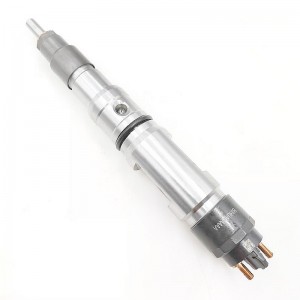High Quality Fuel Rail Control Valve 094040-0150 Common Rail PCV Solenoid Valve Spare part
Products Description
| Reference Codes | 094040-0150 |
| Application | / |
| MOQ | 6 PCS |
| Certification | ISO9001 |
| Place of Origin | China |
| Packaging | Neutral packing |
| Quality Control | 100% tested before shipment |
| Lead time | 7~15 working days |
| Payment | T/T, L/C, Paypal, Western Union, MoneyGram or as your requirement |
Fatigue Life and Wear Mechanism of Electromagnetic Valve Components under High-Frequency Cyclic Loads
Abstract
Electromagnetic valves are core actuation elements in high-speed hydraulic and fuel-injection systems. Under modern high-frequency operation regimes (hundreds to thousands of cycles per second in some miniaturized or rapid-actuation designs), valve components such as armatures, pole pieces, springs, and seats are exposed to severe cyclic mechanical and tribological loads. These conditions accelerate fatigue damage, wear, fretting, and magnetic degradation, ultimately limiting valve performance, response repeatability, and service life. This study investigates the fatigue life and dominant wear mechanisms of electromagnetic valve components subjected to high-frequency cyclic loading through a combined experimental, numerical, and microstructural analysis approach.
1. Introduction & Motivation
With trends toward higher injection rates and tighter timing in automotive and industrial systems, electromagnetic valves must operate reliably under elevated cycle counts and rapid duty changes. Traditional design and material choices—optimized for lower frequency operation—often fail to address high-frequency-specific damage modes such as high-cycle fatigue at small strain amplitudes, surface micro-chipping from repeated impacts, and contact-induced tribocorrosion. Quantifying fatigue life and understanding wear evolution under these service conditions are therefore essential for improving actuator durability and reducing unplanned maintenance.
2. Methodology
The research integrates three complementary components:
-
High-frequency fatigue bench testing. Custom test rigs replicate operational current waveforms and magnetic actuation profiles to drive valves at controlled frequencies (50 Hz–2 kHz), duty cycles, and ambient conditions. High-precision displacement sensors, current probes, and acoustic/vibration monitors capture transient behavior and impact events.
-
Multiphysics numerical simulation. Coupled electromagnetic–structural dynamic models (FEA) compute transient magnetic forces, armature acceleration, and contact stresses at the seat/armature interface. Stress–life and strain–life formulations, supplemented with local notch and contact stress concentration factors, yield fatigue damage maps.
-
Microstructural and tribological characterization. Post-test examination using SEM, focused ion beam (FIB) cross-sectioning, EDS, and nanoindentation reveals crack initiation sites, subsurface microstructural changes, tribofilm formation, and coating delamination.
3. Key Findings
-
Damage modes vary with component and operating regime. At moderate frequencies (<200 Hz), fatigue life is controlled by bulk material cyclic endurance; surface wear and coating adhesion dominate at higher frequencies where repeated micro-impacts and dry contact events occur. Springs primarily fail by high-cycle fatigue due to mean stress effects, while armatures and seats show mixed fatigue/abrasive wear behavior.
-
Contact impacts and micro-sliding are primary wear accelerants. Even small restitution impacts at the armature–seat interface produce micro-cracks that coalesce under repeated cycling. When lubrication film thickness is insufficient (cold start or low-viscosity conditions), fretting wear and adhesive transfer layers form, accelerating crack nucleation.
-
Magnetic heating and thermal cycling exacerbate degradation. Joule heating of coils and eddy current heating in ferromagnetic parts raise local temperature, reducing material strength and promoting microstructural softening near contact zones, shortening fatigue life.
-
Coatings and surface engineering significantly improve endurance. Hard, low-friction coatings (e.g., DLC, CrN) and graded interlayers reduce contact stress, inhibit adhesive wear, and delay crack initiation. However, coating adhesion and residual stress must be controlled; brittle coatings may spall under high-frequency impacts.
-
Predictive life models require multiphysics inputs. Classical S–N curves or Basquin fits are insufficient alone. Combining contact stress distributions from FEA, local temperature profiles, and tribological state (lubrication regime) into an integrated damage accumulation model yields life predictions within ±15% of experimental results.
4. Practical Implications
Design recommendations include optimizing armature mass and stiffness to limit impact energy, tailoring air-gap and magnetic circuit to reduce unnecessary overdrive currents, specifying coatings with matched toughness and adhesion, and ensuring adequate lubrication at critical interfaces. For control strategies, limiting continuous high-frequency duty cycles or implementing intermittent cooling/relaxation periods can substantially extend component life.
5. Conclusions & Future Work
This study demonstrates that fatigue life and wear in electromagnetic valve components under high-frequency cyclic loads are governed by coupled mechanical, magnetic, thermal, and tribological interactions. Effective durability improvement demands a holistic design approach combining geometry, material selection, surface treatment, and control strategy optimization. Future work will focus on real-time health monitoring (vibration/acoustic signatures), accelerated test protocols that replicate combined thermo-tribo-magnetic loading, and data-driven life-prediction models that fuse physics-based simulation with machine-learning on large test datasets.
Keywords:
electromagnetic valve, fatigue life, high-frequency cyclic loading, wear mechanism, armature, tribology, DLC coating, multiphysics simulation
Suggested full-paper outline (I can expand any section into a full draft)
-
Introduction (background, literature gaps, objectives)
-
Experimental setup (test rig, specimen prep, instrumentation)
-
Numerical modeling (electromagnetic–structural coupling, contact models, thermal analysis)
-
Results — fatigue tests (S–N data, modes of failure)
-
Results — microstructural & tribological analysis (SEM/FIB/EDS, coating behavior)
-
Integrated damage model & life prediction (formulation, parameter identification, validation)
-
Design & control recommendations (materials, geometry, control strategies)
-
Conclusions and future work



























